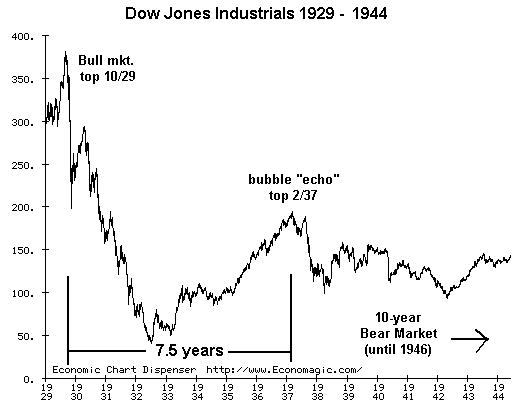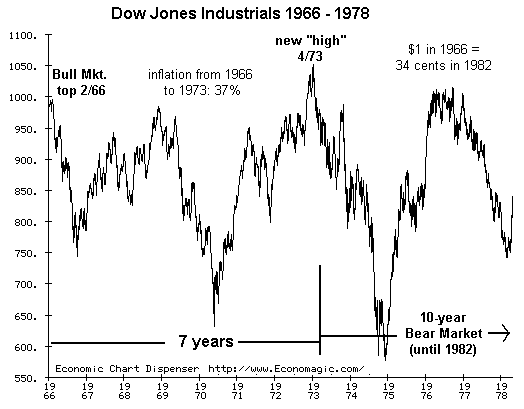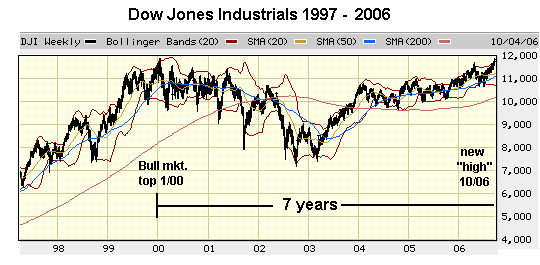

|
| weblog/wEssays archives | home | |
|
Do You Trust this Market Rally? (October 6, 2006) For your consideration--three charts of The Dow Jones Industrial Average: the Great Depression Bear Market 1929 - 1946, the Bear Market 1966 - 1982 and the present. 


Do you see a rather obvious pattern in all three cases? A seven-year "recovery" period from a Bull Market top ends in a dramatic cliff-dive, launching a 10-year Bear Market in which the market, adjusted for inflation, either declines or declines precipitiously. Rather ominously, we are very near the 7-year mark in this glorious "recovery." But why oh why would this outstanding prosperity end so abruptly when all the metrics so beloved of pundits are so robust? To wit: unemployment (low), inflation (practically zero), interest rates (low and set to fall), wealth (rising), stock market (up), real estate (up for a decade), oil prices (dropping). I would submit that all that is nice, but it rests on shaky foundations: 1. An unprecedented housing bubble which is just beginning a multi-year decline to unforeseen depths and financial losses for all participants. 2. An unaffordable, inefficient and morally corrupt (i.e. 46 million uninsured and another 50 million with lousy coverage or coverage which hangs by a thread) "healthcare system" (more like an "illness archipelago") which is poised for either collapse or revolution, take your pick. 3. Federal and local government deficits and/or unfunded liabilities (entitlements, rich public union employee pension plans, etc.) which are set to explode. 4. $265 trillion in "risk-free" derivatives--20 times the entire U.S. economy and five times the global economy--are about to be revealed as a stupendous risk. From The Economist:5. A structural Federal deficit largely funded by foreign central banks and investors is about to be revealed as a liability beyond our control. 6. An unprecedented (7% + of GDP) structural trade deficit/current account deficit is about to be revealed as an unsustainable system whose breakdown will have unfortunate consequences for the dollar and the American lifestyle of endless consumption on someone else's (borrowed) dollar. In summary: the tenuous equilibrium in these unstable systems is near the breaking point. History suggests an almost Biblical pattern of 7 years of post-peak stability will end with a collapse in stocks (and maybe bonds, too, this time around) and a decade-long recession/period of financial malaise/decline. Ignore it at your own risk; think "capital preservation," please. And while we're on the stock market, a lagniappe: here's an oh-so-truthful (at least in my experience) haiku on the market by my good friend Steve T.: when it comes to stocks I coulda shoulda woulda done the opposite For more on this subject and a wide array of other topics, please visit my weblog. copyright © 2006 Charles Hugh Smith. All rights reserved in all media. I would be honored if you linked this wEssay to your site, or printed a copy for your own use. |
||
| weblog/wEssays | home |